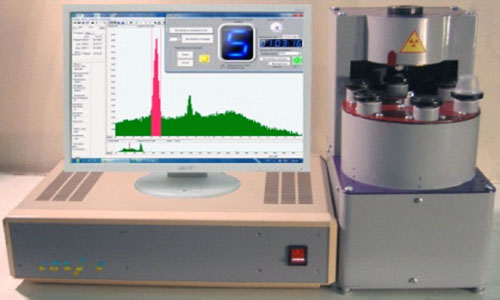
The department provides analytical support and research on materials science, environment and biomedicine based on the experimental study of the interaction of ion beams, X-ray and gamma radiation with matter and the development of new equipment.
The experimental results have been published in more than 300 publications. Click here to see a more detailed list of papers.
Major achievements
A nuclear-physical method was developed using a broadband X-ray filter for non-destructive determination of Hf with low concentration in the products made of zirconium alloys using a proton beam released into the atmosphere.
Hf concentration was measured and the homogeneity of Hf distribution of in the Zr1% Nb ingots obtained by the electron-beam melting with electromagnetic stirring, without electromagnetic stirring and with centrifugal casting was determined. It was found that when using the first melting method, the ingot had a uniform Hf distribution with the concentration of less than 0.05% (normative document).
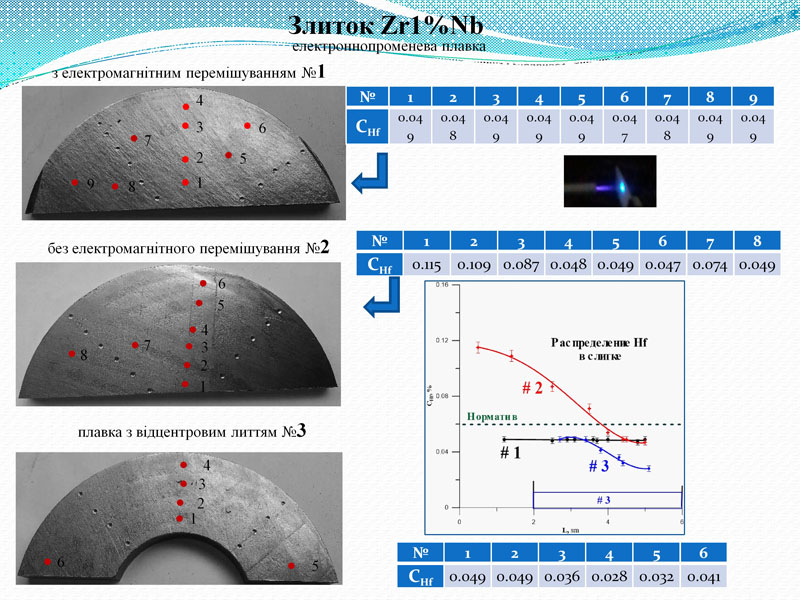
The influence of welding and final etching of the fuel element on the change in the elemental composition of metal in the weld and near-weld area was studied by the nuclear-physical methods. It is shown that the substitutional impurities form a local concentration peak in the heat-affected area which is higher than the nominal concentration by 1.5 – 2 times. Metal impurities tend to be unevenly distributed in the weld and near-weld area depending on the impurity atom radius in relation to the main metal atom radius, and fluorine forms the area of increased concentration in the near-surface layer up to 0.5 μm thick.
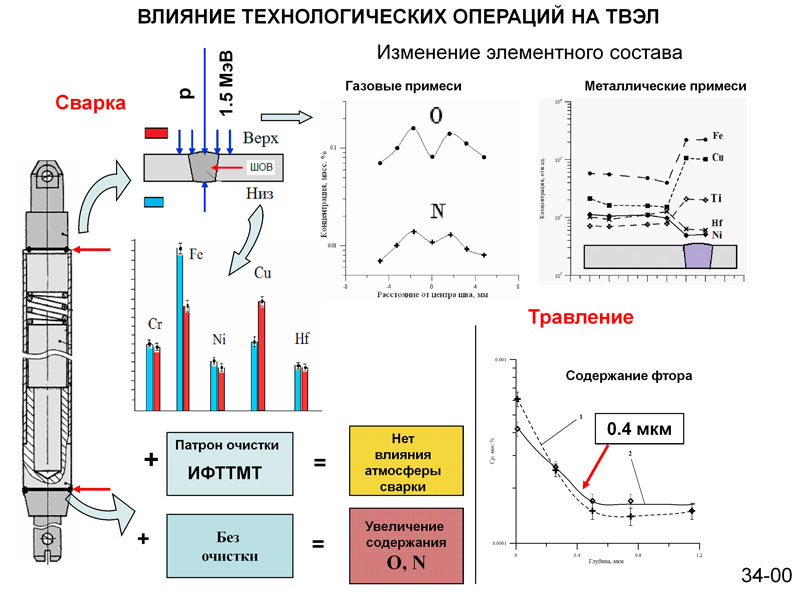
Study of the polymer radiation resistance
Oxygen losses in mylar (C10H8O4)n samples under the action of bombardment with 1 and 1.6 MeV protons in a vacuum within the fluence range from 5 × 1012 to 2.6 × 1016 cm−2 at the current density of 1 μA/cm2 were investigated. Oxygen depletion was studied in situ using the proton backscattering spectrometry. The correlation between the oxygen concentration n and the fluence φ was studied for the near-surface layer of the sample (0.9 μm for the proton energy of 1 MeV and 1.9 μm for the energy of 1.6 MeV). The approximation n = n0exp(− σφ) was used for the initial section of the dependence n(φ) (up to a 20% decrease in oxygen concentration). Here, σ – is the oxygen depletion cross-section. The measured cross-sections were 1.2 × 10−7cm2 (± 25%) for the proton energy of 1 MeV and 1.1 × 10−17 cm2 (± 14%) for the energy of 1.6 MeV.
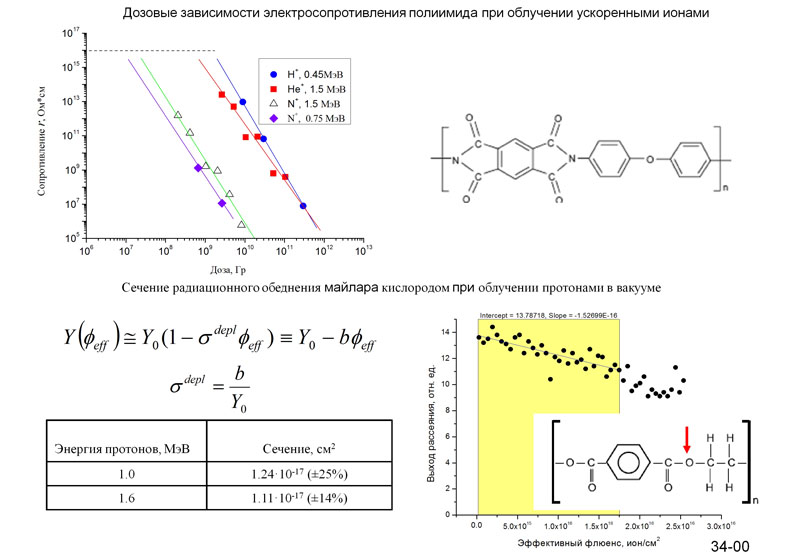
A laboratory process of fluorination was developed using the samples simulating the waste from the government enterprise “SkhidHZK” and production association “Pridneprovsky chemical plant”. It is shown that in the process of fluorination, at least 90% of silicon and tungsten is removed in the form of gaseous fluorides, due to which the total amount of solid waste is reduced by 60 – 65%. Radioactivity of the waste from these enterprises can be significantly reduced due to the release of uranium at the gas-fluoride treatment.
The air in the operation area was investigated at different stages of the fluorination process in order to determine the potential negative environmental factors when introducing the gas-fluoride technology. It was found that the observed fluctuations in the concentrations of elements under different operating conditions of the plant meet the requirements for the workplace air quality.
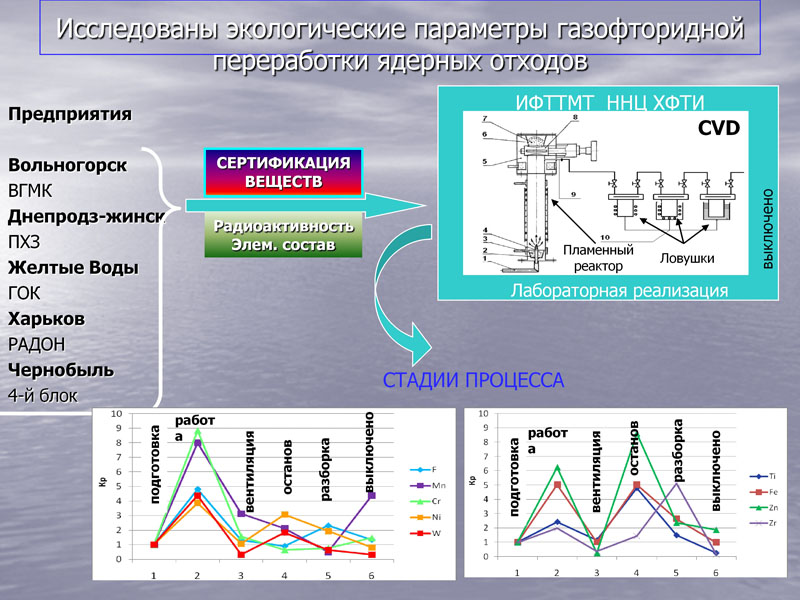
A multiply charged ion source was developed at the NSC KIPT analytical nuclear-physics complex “Sokol”, and two methods for separating 4Не2+ and Н2+ beams were experimentally investigated, namely: the use of existing separating magnet and electrostatic analyzer, as well as the destruction of Н2+ ions when passing through the carbon film. It is shown that these methods make it possible to significantly reduce the concentration of Н2+ ions in the 4Не2+ beam.
The obtained 4Не2+ ions with the energy of 3 MeV were used to study the multilayer structure, which consists of 14 alternating layers of Та2О5 and SiO2, and which cannot be investigated in the version of the previous energies.
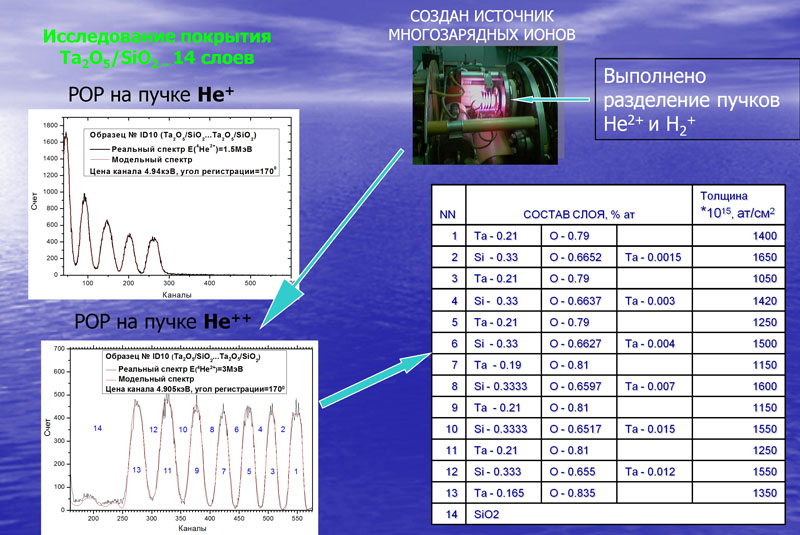
The uniformity of element distribution in ODS-steels was studied.
The distribution of rare-earth elements in ODS-steels was studied using the proton beam injected into the atmosphere at ANPC "Sokol". For the analysis, two types of samples were used: those obtained by the vacuum arc melting and by the method of powder sintering from the 12Kh18N10T industrial steel, into which the strengthening particles ZrO2 stabilized with Y2O3 and having the grain size of 0.1 – 0.5 μm were injected.
As a result of the experiments, the following conclusions can be drawn:
– the non-destructive method was developed for studying oxide dispersion-strengtened steels using the proton beam injected into the atmosphere, with which it is possible to determine both the elemental composition of the samples and their distribution;
– the method for analyzing the distribution of yttrium and zirconium oxides by varying the size of proton beam was developed;
– electropolishing results in the change of element concentration on the sample surface;
– the dependence of chemical element concentration on the proton beam diameter was found.
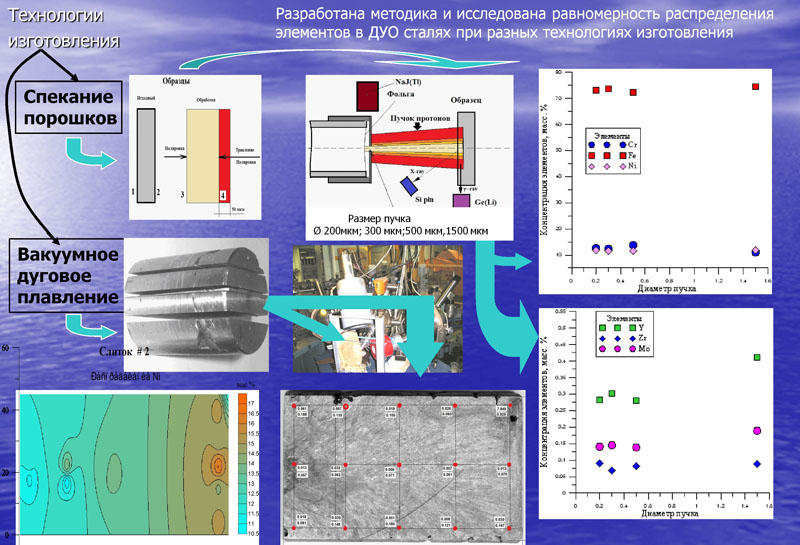
The state of radiation-hazardous objects of VO "PCP" was analyzed. Their potential environmental hazard was identified. The elemental composition and activity of waste samples from VO "PCP" were studied by the nuclear-physical methods. It was found that their main components are silicon and calcium oxides.
On the basis of studies on the process of fluorination for the samples simulating the waste from VO "PCP" (tailing pond Suhachevskoe 1), the possibility of the accumulated waste treatment by the gas-fluoride method was shown. The material and technical costs of treatment at the specially developed plant (SPP) were calculated for one of the largest and most dangerous storage sites – the Sukhachevskoe tailing pond, section 1, which contains 19 million tons of waste.
It is shown that when using 10 gas-fluoride plants with the waste treatment capacity of 100 tons per hour, the entire volume of the tailing dump can be treated in 27 – 30 years. The amount of solid waste will decrease to 7.6 million tons. In accordance with the classification, they will become low-hazard (4 KN) and can be used as an insulating material, as well as for various planning works in the territory development.
Publications
| 1. | P. Dimitriou, H.W. Becker, I. Bogdanovic-Radovic, M. Chiari, A. Goncharov, A.P. Jesus, O. Kakuee, A.Z. Kiss, A. Lagoyannis, J. Raisanen, D. Strivay, A. Zucchiatti. Development of a Reference Database for Particle-induced Gamma-ray Spectroscopy. Nuclear Instruments and Methods in Physics Research Section B: Beam Interactions with Materials and Atoms. 2016, v. 371, p. 33 – 36. |
|---|---|
| 2. | Development of a Reference Database for Particle Induced Gamma Ray Emission (PIGE) Spectroscopy. IAEA-TECDOC-1822. International Atomic Energy Agency, Vienna. 2017, 246 p. |
| 3. | M.F. Kozhevnikova, V.V. Levenets, I.L. Rolik, A.A. Shchur. The Radioactive Contamination Territory of Ukraine by Pu and 241Am Radionuclides Due to the Chernobyl Accident. Problems of Atomic Science and Technology. Series «Nuclear Physics Investigations». 2017, No. 3(68), p. 26 – 30. |
| 4. | Г.Д. Коваленко, В.И. Витько, А.В. Хабарова, В.В. Карташев, Г.В. Гутков, В.В. Левенец. Оценивание экологического риска выбросов летучей золы и её составляющих Змиевской ТЭС с учётом фракционного состава. Ядерна енергетика та довкілля. 2017, №1(9), с. 38 – 44. |
| 5. | В.В. Левенец, А.Ю. Лонин, А.П. Омельник, В.И. Соколенко, А.А. Щур. Сравнительная оценка сорбционных свойств углеродных фильтров, использующихся в системе вентиляции АЭС, с использованием 131І и 127І. Ядерна фізика та енергетика. 2017, т. 18, №1, с. 37 – 42. |
| 6. | V.N. Bondarenko, A.V. Goncharov, V.I. Sukhostavets, T.Kh. Salikhov, A.A. Abdurahmonov. Temperature Monitoring of Polymer Films Under Irradiation by Fast Ion Beam. East European Journal of Physics. 2017, v. 4, No. 1, p. 62 – 69. |
| 7. | V.V. Levenets, A.Yu. Lonin, O.P. Omelnik, A.O. Shchur. Comparison of the Methods Based on the Radiometric Analysis and Characteristic X-Ray Radiation for Definition of Strontium by Zeolites. Methods and Objects of Chemical Analysis. 2018, v. 13, No. 2, p. 64 – 70. |
| 8. | O.P. Omelnyk, V.V. Levenets, A.Yu. Lonin, I.V. Shevchenko, A.O. Shchur. Determination of the Content of Hf in Zirconium Alloys with using a Wide Band X-Ray Emission Filter. Methods and Objects of Chemical Analysis. 2018, v. 13, No. 4, p. 66 – 71. |
| 9. | A.Yu. Lonin, V.V. Levenets, O.P. Omelnik, A.O. Shchur. Use of Mathematical Modeling for Comparative Evaluation of Sorption Capacity of Natural and Synthetic Zeolites in Relation to Cesium. Nuclear Physics and Atomic Energy. 2018, v. 19, No. 1, p. 63 – 68. |
| 10. | V.V. Levenets, A.Yu. Lonin, A.P. Omelnik, I.V. Shevchenko, A.O. Shchur, P.N. Vyugov, D.V. Koblik. The Studying Of The Uniformity Of Distribution Of Hafnium At The Production Of Alloys On The Base Of Zirconium. Problems of Atomic Science and Technology. Series «Physics of Radiation Effect and Radiation Materials Science». 2018, No. 2(114), p. 103 – 108. |
| 11. | A.Yu. Lonin, V.V. Levenets, O.P. Omelnik, A.O. Shchur. Comparison of the Sorption Properties of Natural and Synthetic Zeolites for the Purification of Aqueous Solutions from Cobalt: Sorption of the Cobalt from Aqueous Solutions in Dynamic Conditions and the Quantitative Determination of Cobalt by the PIXE Method. Journal of Radioanalytical and Nuclear Chemistry. 2018, v. 315, No. 2, p. 163 – 169. |
Employees
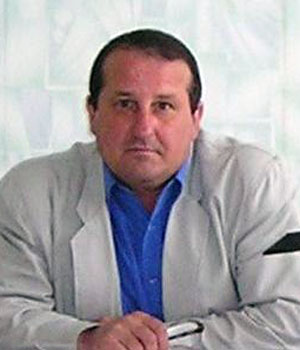
LEVENETS VLADIMIR VIKTOROVICH
Head of Department
D.Sci. in Physics and Mathematics by the specialty 01.04.21 – "Radiation Physics and Nuclear Safety"
Professor
Phone. +38(057) 349-10-60, +38(050) 343-19-13
e-mail: levenets@kipt.kharkov.ua
Research interests:
investigation of the materials for nuclear power engineering using nuclear-physical methods.